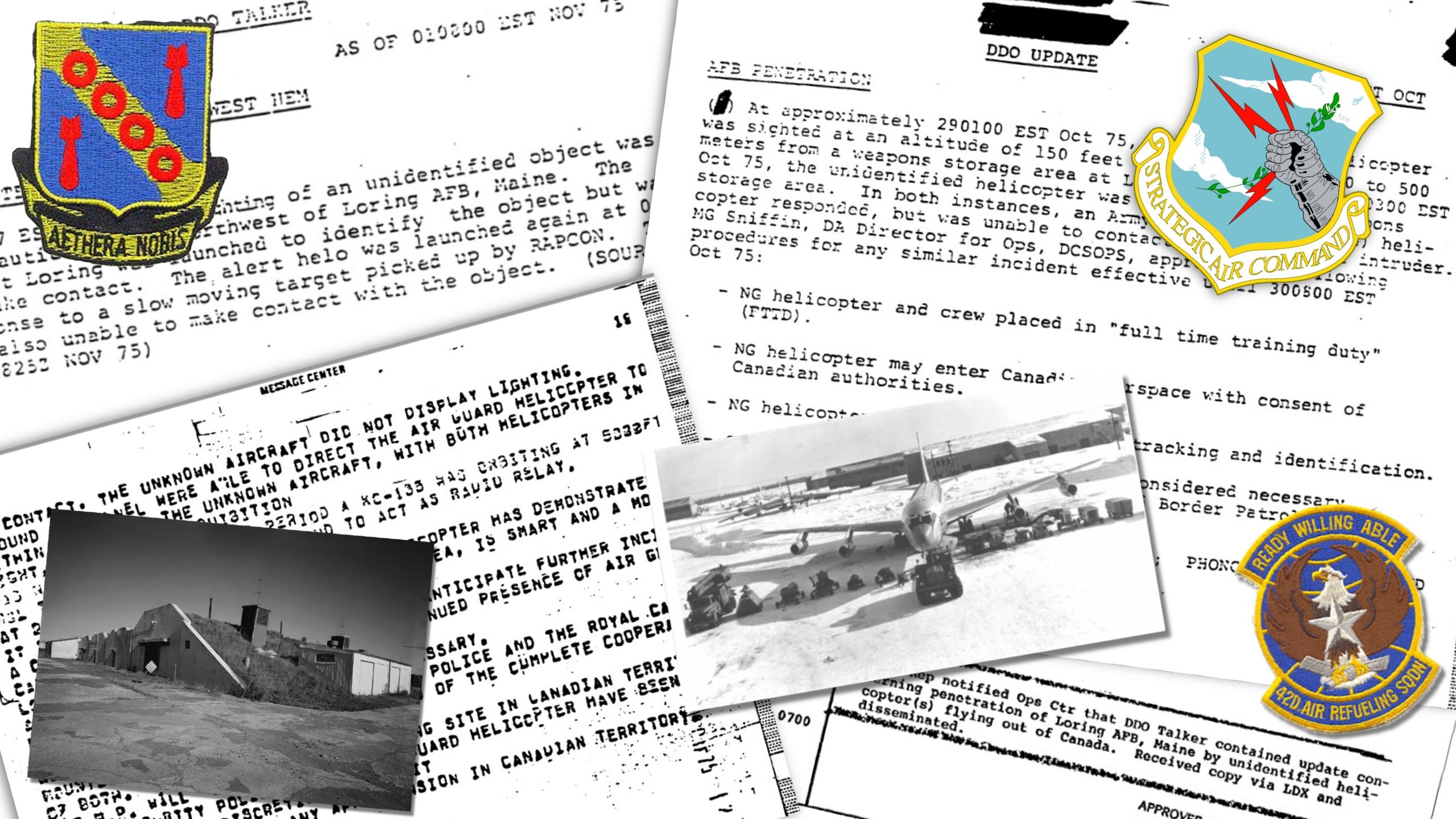Despite the newfound attention the topic of unexplained incursions into airspace over sensitive locales across the United States is receiving, these types of bizarre incidents are not necessarily new. One of the most puzzling accounts of such an event, or series of events, occurred during the depths of the Cold War.
Over a series of nights in 1975, Loring Air Force Base in Maine was invaded by mysterious craft originating from Canadian airspace. At the time, the base was home to B-52 bombers and KC-135 tankers and was tasked with the nuclear alert mission. The Loring AFB incidents are extremely well documented, both in terms of personal testimonials and declassified CIA and National Military Command Center (NMCC) documents. What also made the events so interesting was just how many people were involved or knew about the potential threat and the reaction to it. It was truly a community-scale ordeal that even made its way into the national press. Considering we are talking about a base that housed nuclear weapons and a delivery system for those weapons, the bombers and tankers they rely on, the concern regarding the strange incursions was extreme, to say the least.
What is also interesting about the bizarre events at Loring Air Force Base in the fall of 1975 was what was going on elsewhere, as well. Based on additional official documentation and reports, similar occurrences were remarkably widespread during this time period, albeit few, if any, were as widely experienced or as public in nature.
Unidentified ‘Helicopters’ Appear Over Loring Air Force Base
It was October of 1975. At the time, Loring Air Force Base was a Strategic Air Command (SAC) base that housed two KC-135 tanker squadrons and a B-52 bomber squadron, which had the alert nuclear weapons delivery mission. It was SAC’s easternmost base in the continental United States, putting it in a unique position to quickly respond to a crisis.
The strange affair began on the evening on October 27 when security personnel at the base observed what was described officially as “an unidentified helicopter” that appeared near the northern perimeter of the installation. The aircraft was said to be flying at a low altitude, estimated to be around 150 feet, and appeared to feature a red navigational light and a white strobe. The helicopter seemed to be particularly interested in the highly-secure nuclear weapons storage area at Loring. Army National Guard helicopters were dispatched in an attempt to contact and identify the aircraft, but those attempts proved unsuccessful. The base was immediately put on high alert.
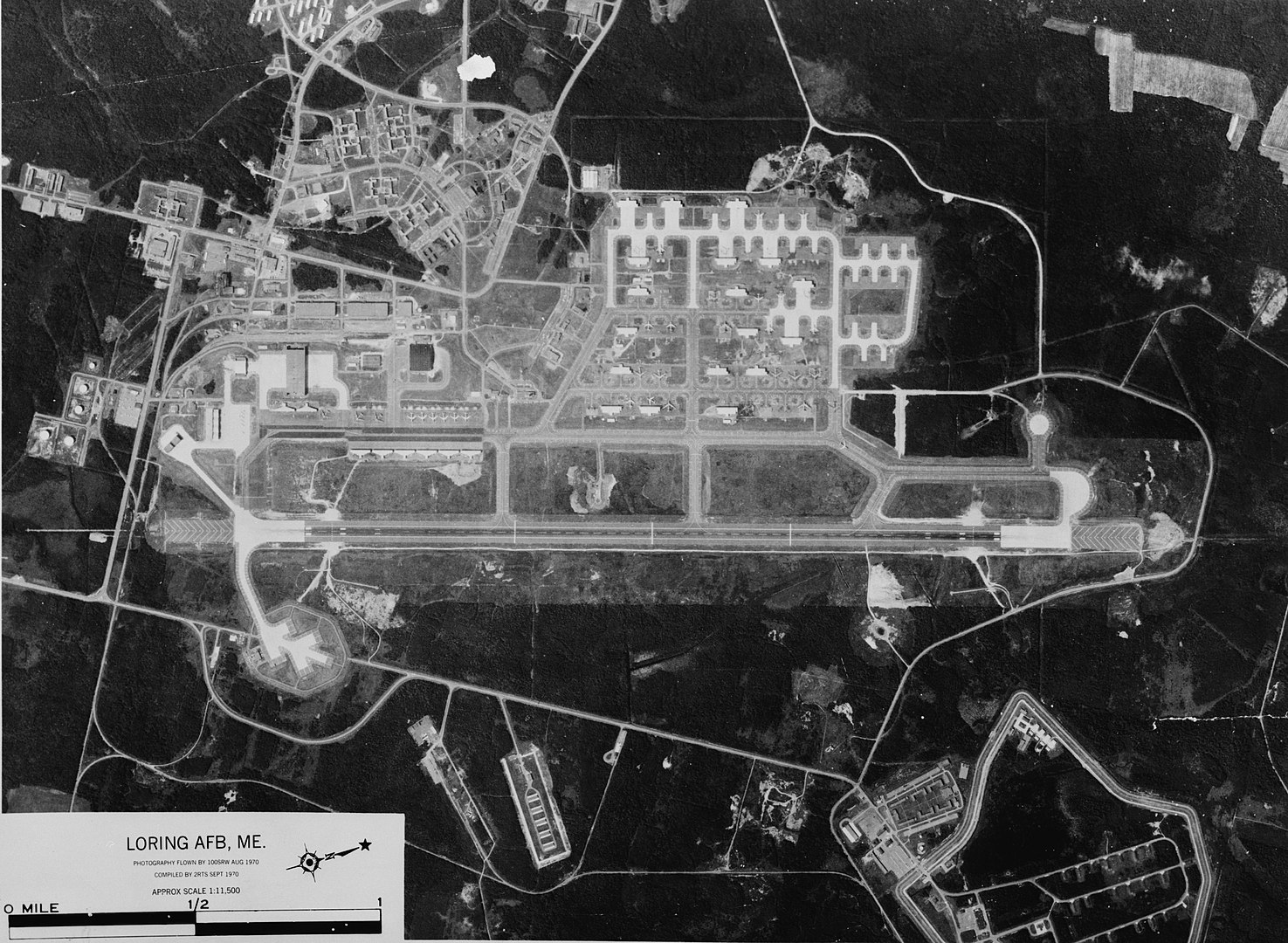
Shortly after the craft appeared, radar operators in the control tower at Loring observed another unknown aircraft circling between 10 and 13 miles northeast of the base. Once again, that aircraft could not be identified despite numerous attempts to make contact by radio on both civilian and military channels. The first unknown aircraft eventually turned north and flew into Canada near Grand Falls, New Brunswick, and the second unknown craft vanished from radar, possibly landing or descending below radar coverage.
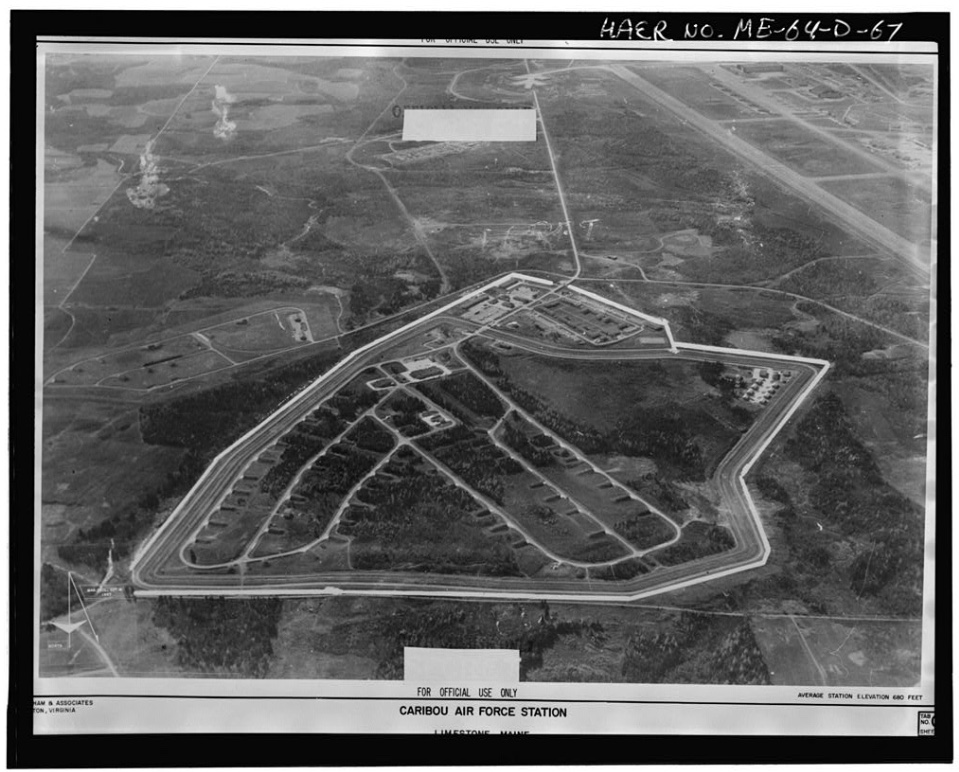
The next night, on October 28, another unknown aircraft appeared over Loring, this time without lights. Once again, National Guard helicopters were sent to investigate, but were unable to establish visual confirmation of the aircraft. In an Operation Report (OPREP) issued after the incident, officials wrote that “It is our opinion that the unknown helicopter has demonstrated a clear intent in the weapons storage area, is smart and a most capable aviator.” The incidents continued through at least October 30th.
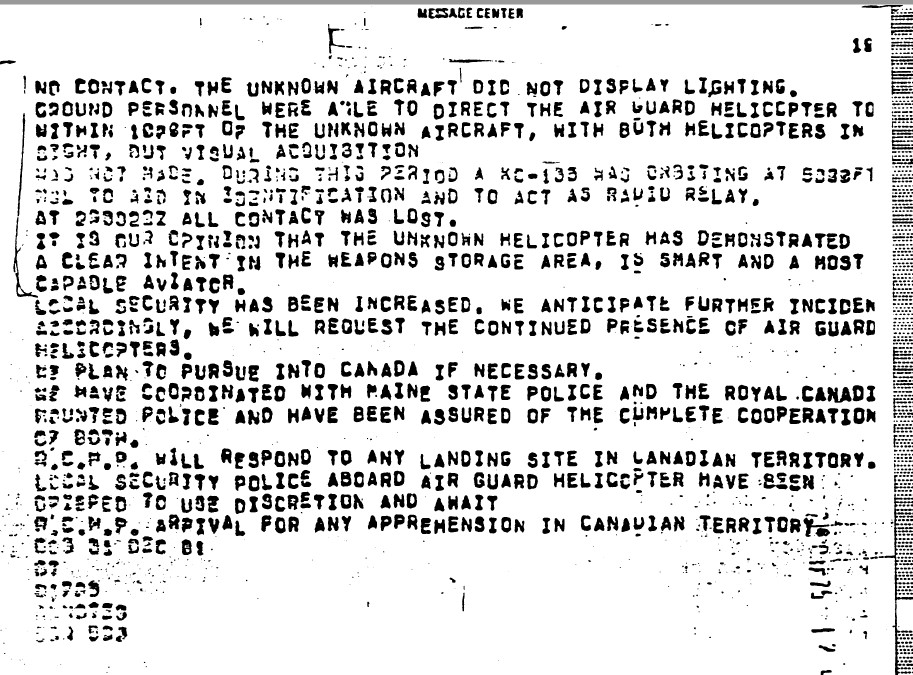
In response to the incursion, Loring increased its local security presence and coordinated with Canadian authorities to allow U.S. aircraft to pursue the offending aircraft into Canadian airspace should the unknown aircraft return.
The New York Times
reported on the incursions in the 1979 article “U.F.O. Files: The Untold Story,” adding that despite the fact the Joint Chiefs of Staff received multiple briefings on the incursions, “Subsequent investigations by the Air Force into the sightings at Loring Air Force Base, Maine, where the remarkable series of events began, did not reveal a cause for the sightings.”
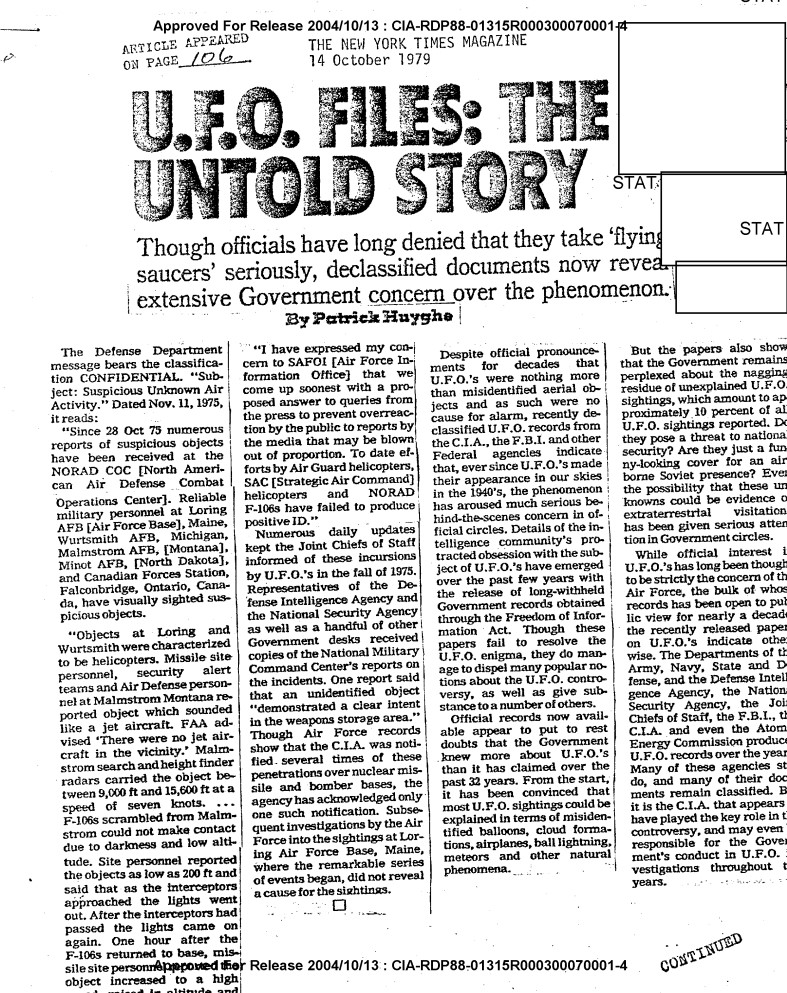
Eyewitness Accounts Complicate The Helicopter Narrative
One account of the aerial intrusions at Loring comes from Arthur Beers, who served at the base from 1970 to 1976. In an account posted to LoringRemembers.com, a site dedicated to chronicling the experiences of the many men and women who served at Loring, Beers described his “most memorable experience” at Loring:
Probably my favorite story was when I was in the Rated Supplement as a Security Police Shift Commander. I was on duty one evening when the Nuclear Weapons Storage Area was buzzed by a unknown helicopter. Obviously we reported this up channel and I raced out to the storage area. When I arrived, I was told that the National Emergency Command Post was on the line for me. When I talked to the Colonel at the National Command Post and explained what had been reported by my team at the storage area, he gave me orders to shoot down the helicopter if it tried to buzz the area again.
I immediately went out to the brief my SAT Teams on these orders but before I could complete that briefing I was called back to the entry point where I talked with a General Officer who said that the President had been briefed and that my new orders were to shoot only if the helicopter tried to land (ah, heck!). I went out and rebriefed my teams in just the nick of time as the unknown pilot in an unlighted Huey type helicopter came back again and then two more times during my shift. He came back three other nights and then just disappeared. To my knowledge the identity was never discovered.
A interesting side note to this, once the information got up to NORAD that we had this unauthorized flying over the storage area, NORAD launched the F-106 that was on alert at Loring. Not exactly sure how that jet jockey was going to see or shoot at a helicopter, 50 feet off the ground in the Northern Maine woods at night running with no lights, but I guess NORAD had to do something. Never saw the F-106, did see the helicopter.
Other personal testimony complicates the claims that the intruder was actually helicopter. Michael Wallace, a former KC-135 tanker pilot who was stationed at Loring in 1975, shared his own bizarre Loring incursion experience on YouTube:

Wallace states that he was briefed on an incursion over the nuclear-armed B-52s and weapons storage facilities at Loring. Wallace and a few hundred other personnel were informed of a silent, luminous object hovering over the base which could move “very quickly” and “unconventionally” in “rapid, straight-line movements, with straight vertical movements, can turn without any apparent radius in the turn. It’s pretty incredible technology.” The object was openly referred to as a UFO by base personnel.
Wallace goes on to claim that Loring personnel were briefed only to speak to SAC officers about the incursion, not to speak to the press, and that they were “going to tell the press that there was a Canadian helicopter crossing the border and harassing us.” He also notes that interceptors were going to be brought in to assist in the efforts to protect the base and investigate what was going on.
Wallace was eventually sent on a refueling mission in his KC-135 to support F-4 Phantoms for unrelated training when his flight was notified by the base’s command post to switch radio frequencies. The lead KC-135 in the flight was instructed to depart the formation, turn off its lights, go radio silent, and proceed to Loring under its own discretion, something Wallace describes as a highly unusual order.
Wallace remembers hearing “stressed voices” over the radio as the pilots and tower personnel attempted to track the object as it seemed to fly back and forth over the base at incredible speeds. As quickly as the transmissions began, they ended as tower personnel stated simply “We’ve lost it.” When Wallace later saw the pilot of the lead aircraft who was sent to intercept the object, he told Wallace “I can’t talk about it, and you wouldn’t believe me if I could talk about it.”
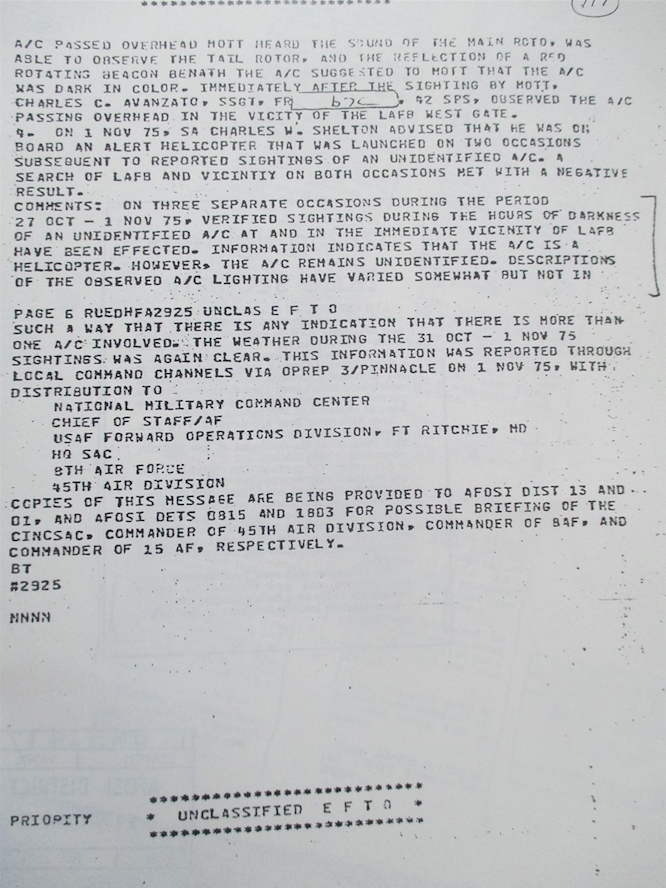
LoringRemembers.com contains numerous other references to the 1975 incursions, with many former Loring personnel calling the incident their most memorable experience. One former Field Maintenance Squadron member remembers “the activity on the flight-line was a frenzy” the night of the incursion.
John E. Morkavich, who served at Loring from 1972 to 1975, recounted the following to LoringRemembers.com:
I was a Hospital Corpsman OR Tech 72-75 and one night in the fall of 73 (I will stand corrected if someone else recalls and has better time line [sic]) the base sirens went off and they said thats [sic] the big one thats [sic] gonna scramble the jets and bombers. About 6 of us got on the roof of the medical barracks and waited for whatever. The base went nuts, claxons, sirens, security police vehicles speeding around lots of flashing lights. Lots of flight line roaring of engines. Well about 3 weeeks [sic] later I was in the Officers Club with Dr John P Sheppard and a couple of pilots were sitting with us. We talked sports and politics then Doc Sheppard asked what the hell happened the other night. They replied with the ubiquitous “Do You Have a Need To Know?” Sheppard said hell yes, so I heard this explanation and both pilots were dead serious.
There was a UFO that came up on radar out of nowhere and was hovering over East Loring near the weapons storage facility. Aircraft was scrambled to intercept, it was seen visually and tracked on radar. Then the Lt Colonel said. “This damn thing was there one second and gone the next, vanished….then radar analysis showed this bogey was so far away and at such a high altitude…..let me tell you this -“… there is NOTHING on THIS PLANET that can do the things this aircraft or damn UFO did….” Then they got up and walked away from the table. Sheppard and I were stunned and we did not talk about it again. This is no BS and I welcome those who were there and remember.
LoringRemembers.com even contains a section called “the official UFO story” which states simply “In 1975, a ‘UFO’ buzzed the WSA over a few nights. Internet lore has stamped this as a true UFO conspiracy involving numerous other bases. The DOD released a declassified report on the incident.”
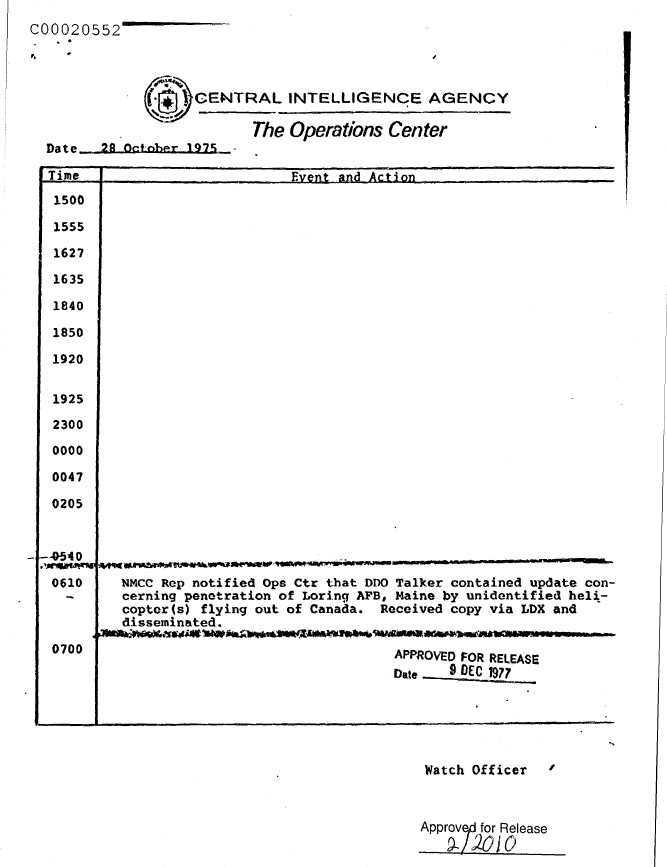
One of the most thorough investigations of the Loring incidents was conducted by Barry Greenwood and Lawrence Fawcett and included in their 1984 book
Clear Intent: The Government Coverup of the UFO Experience. An excerpt from that book containing sections on Loring can be found online here. It goes into great detail as to what the narrative of events was, at least according to their research. We will pick it up on the second night, but we encourage you to read the whole excerpt.
On October 28, 1975, at 7:45 P.M., Sgt. Clifton W. Blakeslee and Staff Sgt. William J. Long, both assigned to the 42nd Security Police Squadron, were on duty at the munitions storage area. Along with Sgt. Danny Lewis, both Sgts. Blakeslee and Long spotted what appeared to be the running lights of an aircraft approaching Loring Air Force Base from the north at 3,000 feet. The aircraft did not come closer to Loring than about three miles at this time, and it was observed intermittently for the next hour.
On first spotting the craft, Sgt. Lewis called the Command Post and advised it that the unknown craft had returned to Loring. Lewis reported that he could see a white flashing light and an amber or orange light. Once again, the Commander, 42nd Bomb Wing responded. Rushing to the area of the storage dump, he observed the unknown craft. He reported seeing a flashing white light and an amber-colored light on the object also. The speed and movement in the air suggested that the craft was a helicopter. From 7:45 P.M. to 8:20 P.M., it was under constant observation, both visually by the personnel in the storage area and electronically by the control tower radar, which showed the craft at a position three miles north of the Loring perimeter.
The unknown craft would appear and disappear from view, and, at one point, appeared over the end of the runway at an altitude of 150 feet. The object subsequently shut off its lights and reappeared over the weapons storage area, maintaining an altitude of 150 feet.
At this time, Sgt. Steven Eichner, a crew chief on a B-52 bomber, was working out of a launch truck along with Sgt. R. Jones and other members of the crew. Jones spotted a red and orange object over the flight line. It seemed to be on the other side of the flight line from where the weapons storage area was located. To Eichner and Jones, the object looked like a stretched-out football. It hovered in midair as everyone in the crew stared in awe. As they watched, the object put out its lights and disappeared, but it soon reappeared again over the north end of the runway, moving in jerky motions. It stopped and hovered. Eichner and the rest of the crew jumped into the truck and started to drive toward the object.
Proceeding down Oklahoma Avenue (which borders the runway), they turned left onto the road that led to the weapons storage area. As they made the turn, they spotted the object about 300 feet in front of them. It seemed to be about five feet in the air and hovered without movement or noise. Exhibiting a reddish-orange color, the object was about four car lengths long. Eichner described what he saw next:
“The object looked like all the colors were blending together, as if you were looking at a desert scene. You see waves of heat rising off the desert floor. This is what I saw. There were these waves in front of the object and all the colors were blending together. The object was solid and we could not hear any noise coming from it.”
They could not see any doors or windows on the object nor any propellers or engines which would keep the object in the air. Suddenly, the base came alive. Sirens began screaming. Eichner could see numerous blue lights on police vehicles coming down the flight line and runway toward the weapons storage area at high speed. Jones turned and said to the crew, “We better get out of here!” They immediately did. The Security Police did not try to stop them. Their interest was in the object over the storage dump, not in the truck which was in a restricted area. The crew drove the truck back to its original location and watched from there. The scene at the weapons storage area was chaotic, with blue lights rotating around, and the vehicles’ searchlight beams shining in all directions.
The men in the crew decided not to report what they had seen, because they had entered a restricted area and could have been arrested for the violation.
The object shut off its lights and disappeared, not to be seen again that night. The 42nd Police conducted a security sweep of the weapons storage area inside and out, with no results. Radar had once again briefly tracked the object heading for Grand Falls, New Brunswick, finally losing the unknown at Grand Falls itself.
Priority messages were sent to the National Military Command Center in Washington, the Chief of Staff of the Air Force, the Air Force Forward Operations Division at Fort Ritchie, Maryland, SAC Headquarters, and the 9th Air Force, 45th Division, advising them that an unknown object had penetrated the base and had been in the nuclear storage area.
The writers interviewed Chief Warrant Officer Bernard Poulin of the Maine Army National Guard’s 112th Medical Company (Air Ambulance), who was tasked with tracking down and identifying the unknown aircraft in a UH-1 as the nightly occurrences wore on in late October. Poulin told Fawcett that despite numerous witnesses seeing and hearing the intruder, his helicopter crew could not get visual confirmation on the aircraft, but gives additional details of his experiencing of walking into the SAC base on high alert for a mysterious intruder:
“Well, we were launched on the first search mission after ground personnel started to see or hear the, quote, if you will, “UFO” go by. So, we would launch, and I believe that we were in the air for around 40 minutes looking for this thing, with the idea that it was a rotary-type craft we were searching for. We were vectored in by ground personnel to different spots on the base where the ground personnel were seeing or hearing it. All this time we were being tracked by base radar [traffic control radar which is designed to pick up aircraft], and radar was not painting the object that was being reported. Ground personnel would call and say the object is at this location, but radar would not pick it up.
Well, anyway, we hunted around, and we didn’t see anything. Again they would call and say they could hear it at a location, and we would go there, but could not see it. We would then shut down and wait for the next call. And that went on for a couple of nights. This, again, was early evening or early in the morning. I can recall on the second night of the mission radar picked up a return, but it turned out to be a KC-135 tanker returning from overseas.”
Poulin was asked: “According to some of the documents, personnel on the ground were reporting that at times you would bring your craft within 100 feet of the intruder, yet you could not see it?” He answered:
“Yes, well, we could go real low to where they said it was and would turn on our search light and sweep the area with the light, but we never saw the craft. After it was over, we discussed our mission. The powers to be were quite concerned about what was going on and if we were able to see anything. They maintained all along up there, you know, those are pretty sensitive places and they have to know what the hell was going on.”
When they arrived at the base, the security lid was on so tightly that both pilots were permitted to call their wives only once to say that they were on a mission. In a meeting with Chapman, Poulin recalled the Commander saying, “We’ve got to keep the lid on the fact that someone has been able to penetrate in and around the bomb dump, and we don’t know what’s going on. We’ve got to find out what is going on and prevent it from happening again.”
Greenwood and Fawcett continue:
At Loring, additional manpower was armed and ready for deployment. The Security Police Battle Staff was to be manned at Central Security Control. An additional two-man mobile patrol was assigned to the weapons storage area during the hours of darkness, while a ten-man reserve force was standing by, ready for deployment. A two-man patrol would be positioned at key vantage points about one mile north of the base for added surveillance. An SAC/SP message informed northern tier bases of the situation and recommended a “Security Option Three” alert all along the U.S.-Canadian border.
The message went to Pease AFB in New Hampshire, Plattsburgh AFB in New York, Wurtsmith AFB in Michigan, Kinchloe AFB in Michigan, Sawyer AFB in Michigan, Grand Forks AFB in North Dakota, Minot AFB in North Dakota, Malmstrom AFB in Montana, Fairchild AFB in Washington, and Barksdale AFB in Iowa. The subject-identifying line of the message was “Defense Against Helicopter Assault,” and it read:
The past two evenings at one of our northern tier bases, an unidentified helicopter has been observed hovering over and in the near vicinity of the weapons storage area. Attempts to identify this aircraft have so far met with negative results. In the interest of nuclear weapons security, the action addresses will assume Security Option 3 during hours of darkness until further notice. Actions also should be taken to re-establish liaison with local law enforcement agencies that could assist your base in the event of a similar incident. Bases should thoroughly review and insure [sic] all personnel are familiar with actions to take in association with the helicopter denial portion of your 207-xx plan.
On October 30, the Maine National Guard helicopter was replaced by a USAF helicopter and crew from Plattsburgh Air Force Base. The following evening there were several reports of unknown objects suspected to be helicopters, at distances varying from directly over the base to 10 nautical miles northeast of the base. Some reports were confirmed on RAPCON radar with altitudes between 300 and 5,000 feet.
Additional, sporadic reports of helicopters continued well into December, though many of these were subsequently identified as normal helicopter traffic. In these reports, however, a distinction was drawn between the October sightings and later reports: Robert Fauk, Deputy Chief Patrol Agent with the U.S. Border Patrol, said he felt that an alleged helicopter report of November 18 was not the “Midnight Skulker of Loring.”
He added, “This craft was too slow and too small to be the craft they had problems with at Loring.”
Strangely enough, the Lewiston Daily Sun newspaper in Maine reported two eyewitnesses encountering a curiously lit aircraft on the morning of October 27, 1975 near the town of Poland. Poland is in the southwest corner of Maine, while Loring was in the northeast, so the two events may be unrelated. Still, it’s curious that two eyewitnesses far from the Air Force Base would describe seeing such a similar aircraft on the same night that the Loring encounters began. Greenwood and Fawcett’s book also claims a rash of civilian sighting occurred around the same time throughout the area.
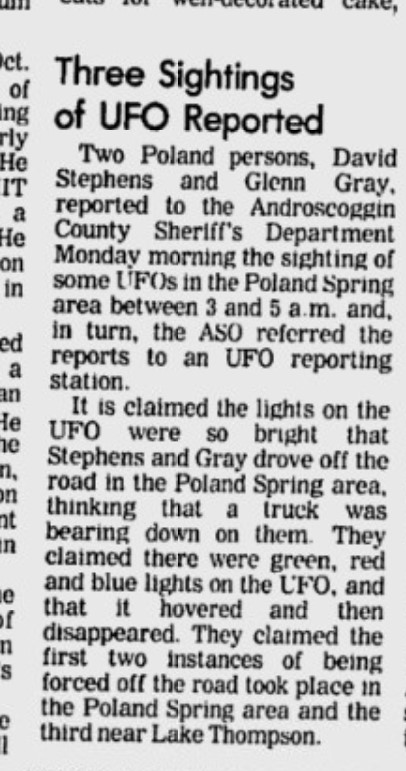
Similar Incursions Continued At Other Military Installations
Eerily similar events occurred at other U.S. Air Force Bases in the months following the incident at Loring AFB, although there is no definitive evidence that any of them were linked. On October 30, just days after the Loring incursion, the now-decommissioned Wurtsmith AFB in eastern Michigan had its own encounter detailed in the missive below.
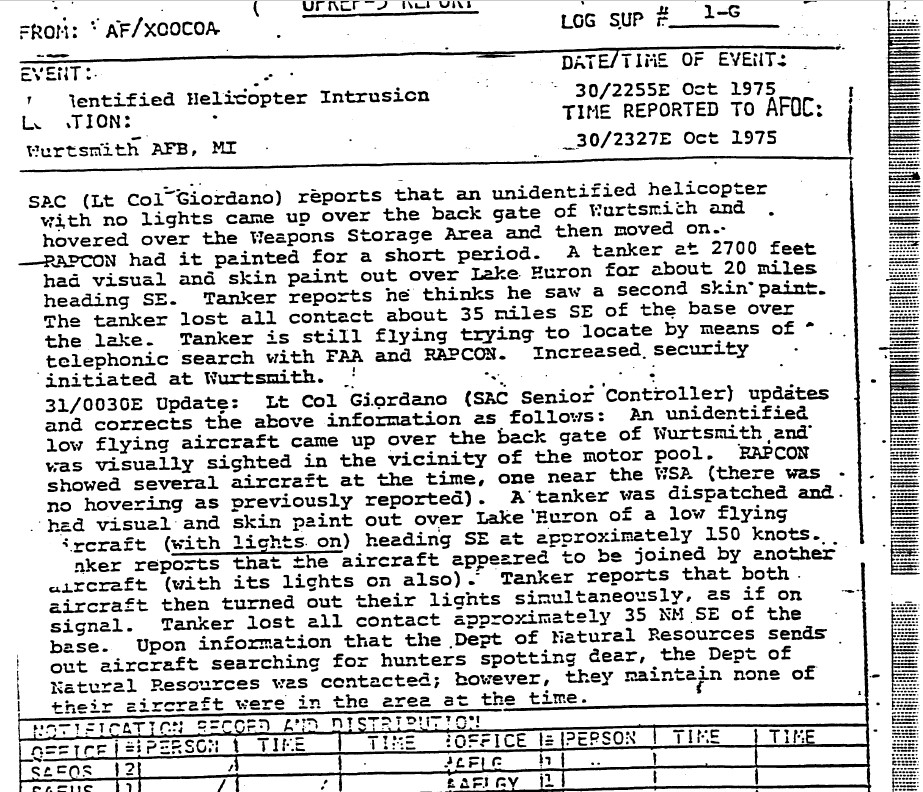
In November 1975, personnel at Malmstrom AFB in Montana, another Strategic Air Command site, encountered bright lights that seemed to be accompanied by jet engine noises. NORAD scrambled two interceptors in an attempt to locate and identify the aircraft, but was unsuccessful in their attempts to do so.
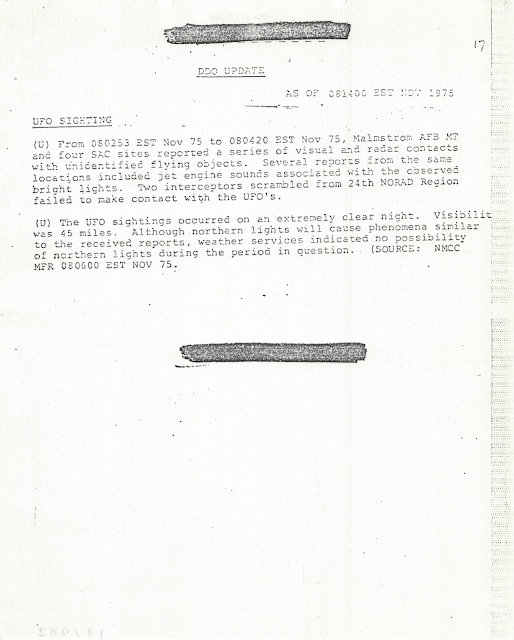
In January of 1976, Cannon AFB in eastern New Mexico reported two unidentified flying objects described as “25 yards in diameter, gold or silver in color with blue light on top, hole in the middle and red light on bottom.”
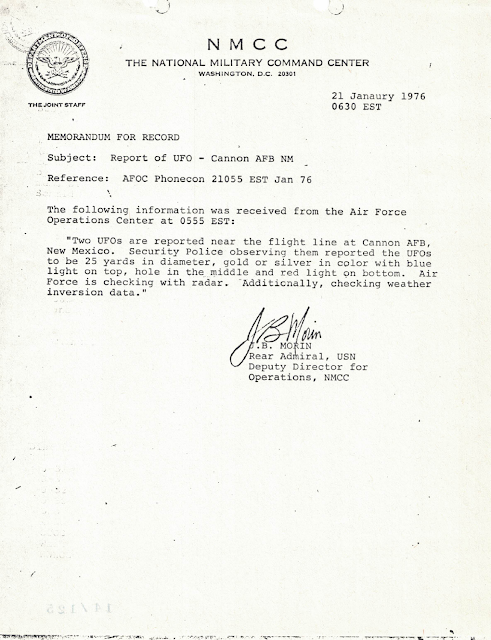
On January 31, 1976, security personnel at Eglin AFB in Florida spotted lights near one of their radar sites, and later issued a press release announcing the incident.
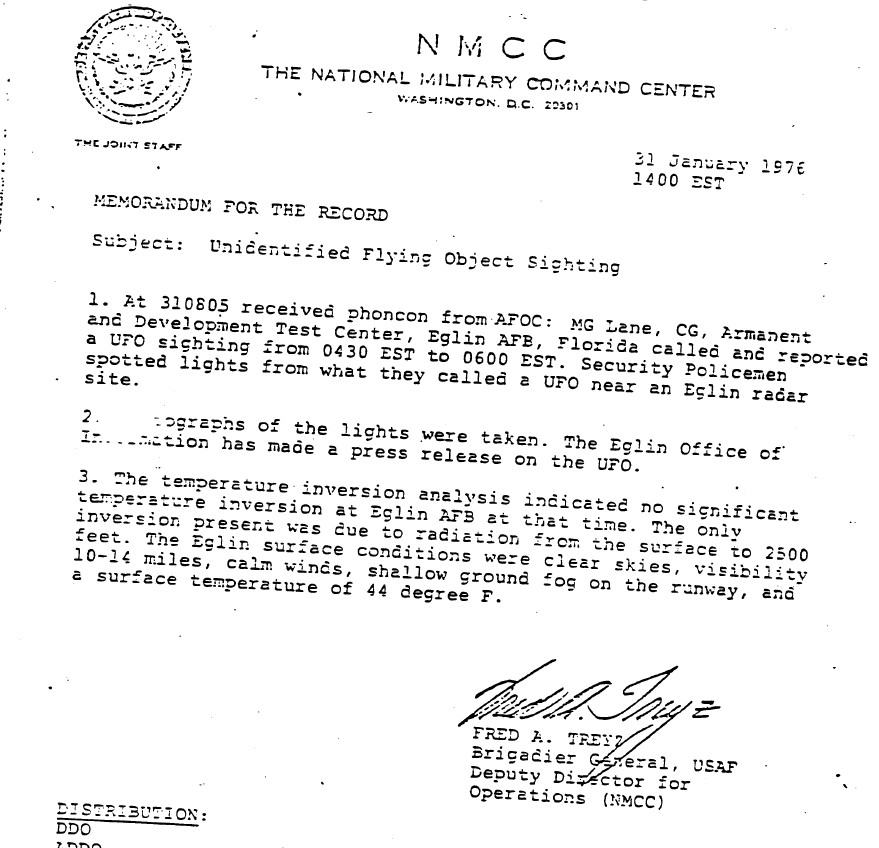
Later that year, on July 30, 1976, security patrols at Fort Richie in Maryland spotted “3 oblong objects with a reddish tint” near ammunition storage areas, although a National Military Command Center memo issued after the incident cites temperature inversions in the area as a possible cause for the unexplained sightings.
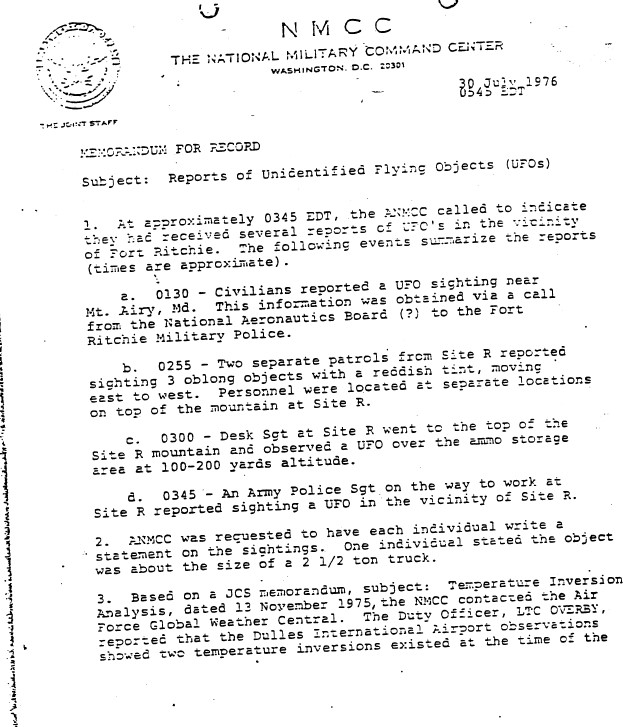
Reporters Ward Sinclair and Art Harris referenced several of these events in a 1979 article in The Washington Post, and wrote that “a Nov. 11, 1975, directive from the office of the secretary of the Air Force instructed public information staffers to avoid linking the scattered sightings unless specifically asked.”
Numerous documents have been declassified via the Freedom of Information Act which shed light on the Department of Defense’s response to the mysterious incidents at Loring and at other bases, some of which are mentioned above. You can read these documents for yourself at the PDF link below.
Loring And Other Base Incursion Incident Files From The Mid 1970s.
An Unsolved Mystery
The 1975 incident at Loring Air Force Base shows that even nearly 50 years ago, some of America’s most strategically sensitive sites were vulnerable to intrusion from mysterious craft. While some reports cite the objects as “helicopters,” multiple eyewitness accounts complicate this characterization by describing jet engine noises, incredible feats of speed and maneuverability, bizarre descriptions of physical craft, and a seeming inability for pilots to get visual confirmation of them.
Whether the multi-day string of aerial intrusion incidents over Loring AFB was perpetrated by a wily helicopter pilot with still unknown motivations, some type of bizarre Cold War strategic gamesmanship, or something even more exotic, remains unclear. The reality is that any of those possibilities are fascinating in their own right.
What is clear is that something extremely strange did happen over the span of at least four nights at Loring in the fall of 1975, incidents that had hundreds of witnesses, some of which have provided direct testimonial as to their experiences. Although personal observations can vary in accuracy greatly, the core aspects of these events are backed up by numerous official documents that reach up to the highest levels of the U.S. military’s command structure. According to other documents from the time period, Loring wasn’t alone in enduring bizarre visits by unidentified aircraft, although in terms of the scope and detail of such incidents, the Loring AFB case seems to have few parallels.
For more information and documentation about the Loring incident and other incursions throughout the 1970s, check out researcher Paul Dean’s extensive nine-part series, at his site, Documenting the Evidence.
If you served at Loring AFB between 1975 and 1976 and witnessed these unexplained incursions, The War Zone wants to hear your story.
Contact the author: Brett@TheDrive.com
